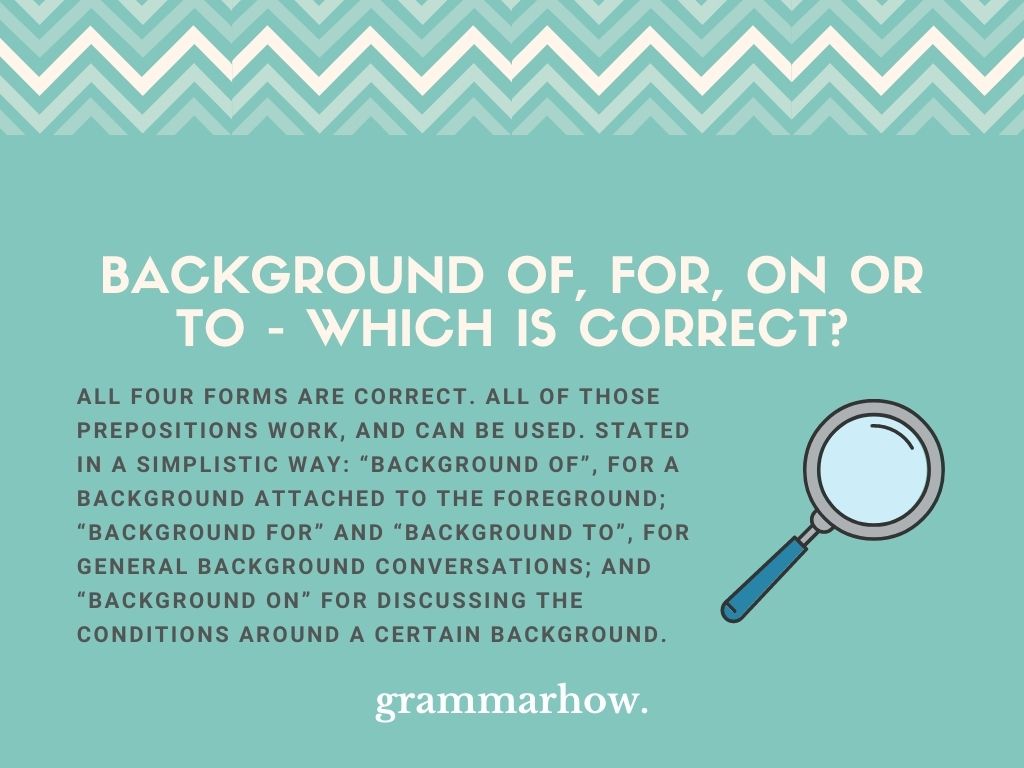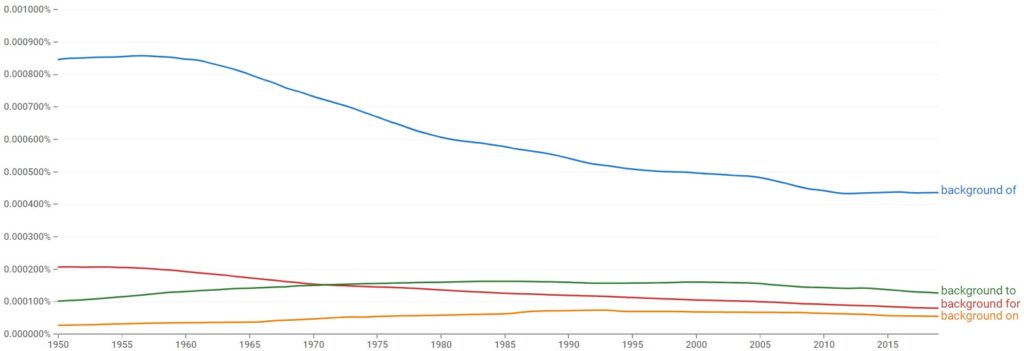Sometimes, prepositions have the power to change an expression and the meaning it carries. When discussing a background, which preposition should we use: “Of”, “For”, “On” or “To”?
Let’s look closely at all the options, to try and find out which ones we should use, and which ones to avoid.
Background Of, For, On or To – Which Is Correct?
All four forms are correct. All of those prepositions work, and can be used. Stated in a simplistic way: “Background Of”, for a background attached to the foreground; “Background For” and “Background To”, for general background conversations; and “Background On” for discussing the conditions around a certain background.

Let’s go over some examples, and see how those prepositions work with “Background”:
- The background of the scene was beautiful.
- The historical background for this event is complex.
- The background to the shoot wasn’t being used by the photographer yet.
- You should set that picture as your background on your phone.
As you can see, we have four examples. Each sentence uses one of the prepositions attached to “Background” and they all work. They might sound a bit unusual, or you might have preferred a different one in that place, but in terms of grammatical correctness, it was all there.
Keep in mind that, all of the four prepositions could be used with the word “Background” and still be grammatically correct. “Background Of” and “Background On” seem to be more common (and we’ll have the chance to confirm that), but all four are acceptable.
Let’s look at each possibility separately.
Background Of
“Background Of” indicates that the background in the sentence belongs to whatever it is attached or related to.
Let’s see some examples:
- The background of the picture was breathtaking.
- The background of the painting included many different flowers.
- The photographer created the background of the shooting. It was classy and chic.
- When Paul proposed to Lina, the background of the scene was whimsical.
- The background of their relationship is quite confusing.
The idea behind “Background Of” is that you cannot detach or remove the background from the picture (in a figurative level, often).
For example, the “Background Of” the painting belongs to the painting and it can’t be removed. How could someone possibly remove it? Same thing with a picture that was taken – although you could make changes using software, by principle that background belongs to that image.
Background For
“Background For” may indicate a reason for the background to exist or a selection, a choice that comes for that background you’re talking about.
Take a look at some examples:
- I need you to select a background for your wedding pictures.
- Drew suggested that you change the background for the presentation.
- Have you checked the new employee background for any violations?
- There’s a background for your decision, and I’d like to hear it.
- The background Carla created for the baby shower was really weird. Should we tell her?
In those sentences, the background in question isn’t attached definitively to what we’re describing. It can be changed, selected, removed, etc. In those cases, “Background For” works and can be used.
Keep in mind, though, as we move along the prepositions, that in many cases, one or more prepositions would work in any particular sentence. Communication (verbal or written) is a form or art, and we can play with the words and change the construction of the sentences.
None of the suggestions are written in stone, and that’s why more than one preposition may function perfectly with the sentences in the examples. It’s ok, and you should feel free to use the preposition you like better.
Background On
“Background On” relates to the conditions connected to the background that’s being discussed in the sentence.
Let’s see some examples:
- Did you check the background on Donna, before offering her a job?
- Can you give me some background on what’s going on?
- I need to share some information with you, regarding the background on the meeting we have tomorrow.
- The background on the negotiation is tricky, and we should go over it.
- I need some background on what’s going on, before giving my input.
The idea when using “Background On” is to discuss a situation, a condition around a topic. It’s not necessarily a fixture, or visible scenario. Often, it’s a conversation, a backstory to something that is happening now or will happen soon.
Background To
“Background To” can be used to talk about the relation between the background and the topic being discussed. It can frequently interchange with the other forms seen before.
Let’s see some examples:
- The background to the inception of my business is quite interesting.
- You should add a background to your videos, like a studio.
- There’s a background to every decision Mark makes.
- We need to understand the background to this crazy idea John wants us to put in place.
- I wish you’d tell me the background to your decision to leave.
“Background To” works as a way to understand the reasons for something, where those ideas or actions are coming from. It’s a way to ask for or provide an explanation for what’s going on.
Which Is Used the Most?
“Background” is a word that can be followed by many prepositions. Those prepositions may or may not change the meaning of the sentence, but they definitely help convey a message and make it more clear.
Of all the options we went over, which one is used more often? “Background Of”, “Background For”, “Background On” or Background To”?
Let’s take a look at the graph from Google Ngram Viewer below, to find out.

“Background Of” is by far the most used form. It appears with more frequency than the others, by a large difference. The other three, “Background For”, “Background On” and “Background To” don’t even compare.
For the ones least used, they seem pretty close together. Still, “Background To” comes second, while “Background On” comes last.
Final Thoughts
The word “Background” can be used with a big variety of prepositions. Use “Background Of”, for a background that is connected to the foreground. Use “Background For” and “Background To” for general conversations. Leave “Background On” for conversations about the state of a situation (its background).

Martin holds a Master’s degree in Finance and International Business. He has six years of experience in professional communication with clients, executives, and colleagues. Furthermore, he has teaching experience from Aarhus University. Martin has been featured as an expert in communication and teaching on Forbes and Shopify. Read more about Martin here.
